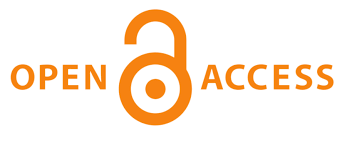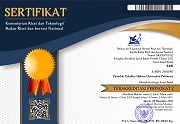The Restorative Justice Orientation to Hoax Spreaders on Social Media: Urgency and Formulation
 ), Khomaini Khomaini(2), Dwi Edi Wibowo(3)
), Khomaini Khomaini(2), Dwi Edi Wibowo(3)
(1) Faculty of Law Saint Thomas Catholic University, Medan, Indonesia
(2) Faculty of Law Pembinaan Masyarakat Indonesia University, Medan, Indonesia
(3) Faculty of Law Pekalongan University, Pekalongan, Indonesia
 Corresponding Author
Corresponding Author
Abstract
Introduction: The development of the use of digital media has had an impact on the amount of hoax information on social media. The large amount of hoax information in the community has made law enforcement officials immediately apply criminal law enforcement against hoax news spreaders.
Purposes of the Research: The urgency and formulation of the application of restorative justice in the crime of spreading hoax information on social media.
Methods of the Research: Normative legal research with a concept and statutory approach.
Results of the Research: The urgency of implementing RJ for perpetrators of criminal acts of spreading hoaxes on social media because RJ's orientation is to provide compensation for victims as well as having a future orientation to educate the public so they can prevent criminal acts from occurring. The application of RJ in cases of criminal acts of spreading hoaxes on social media can be formulated by regulating the application of RJ in cases of criminal acts of spreading hoaxes on social media by revising the provisions of the SKB UU ITE. Revision of the Joint Decree on the ITE Law by incorporating the RJ aspect as an effort to resolve the criminal act of spreading hoaxes on social media as well as the criminal act of the ITE Law in general.Keywords
DOI
10.47268/sasi.v29i4.1580
Published
2023-10-30
How To Cite
@article{SASI1580,
author = {Henny Flora and Khomaini Khomaini and Dwi Wibowo},
title = {The Restorative Justice Orientation to Hoax Spreaders on Social Media: Urgency and Formulation},
journal = {SASI},
volume = {29},
number = {4},
year = {2023},
keywords = {Hoax; Restorative Justice; Criminal Act.},
abstract = {Introduction: The development of the use of digital media has had an impact on the amount of hoax information on social media. The large amount of hoax information in the community has made law enforcement officials immediately apply criminal law enforcement against hoax news spreaders.Purposes of the Research: The urgency and formulation of the application of restorative justice in the crime of spreading hoax information on social media.Methods of the Research: Normative legal research with a concept and statutory approach.Results of the Research: The urgency of implementing RJ for perpetrators of criminal acts of spreading hoaxes on social media because RJ's orientation is to provide compensation for victims as well as having a future orientation to educate the public so they can prevent criminal acts from occurring. The application of RJ in cases of criminal acts of spreading hoaxes on social media can be formulated by regulating the application of RJ in cases of criminal acts of spreading hoaxes on social media by revising the provisions of the SKB UU ITE. Revision of the Joint Decree on the ITE Law by incorporating the RJ aspect as an effort to resolve the criminal act of spreading hoaxes on social media as well as the criminal act of the ITE Law in general.},
issn = {2614-2961}, pages = {633--644} doi = {10.47268/sasi.v29i4.1580},
url = {https://fhukum.unpatti.ac.id/jurnal/sasi/article/view/1580}
}
Journal Article
A, Morissan, Andy Corry Wardhani, and Tri Dhiah Cahyowati. “Who Believes Hoaxes? Xenophobia and Religiosity as Hoax Predictors among Social Media Users.” International Journal of Academic Research in Business and Social Sciences 11, no. 2 (2021): 1–21. https://doi.org/10.6007/ijarbss/v11-i2/8383.
Aebi, Marcelo F., and Fernando Miró-Llinares. “Crime, Criminal Justice, and the COVID-19 Crisis Lockdown: A Special Issue Introduction.” Journal of Contemporary Criminal Justice 37, no. 4 (2021): 476–79. https://doi.org/10.1177/10439862211061887.
Banwell-Moore, Rebecca. “The Delivery of Restorative Justice in Youth Offending Teams in England and Wales: Examining Disparities and Highlighting Best Practice.” Laws 11, no. 4 (2022): 3. https://doi.org/10.3390/laws11040060.
Chen, Shuai, Mengmeng Hao, Fangyu Ding, Dong Jiang, Jiping Dong, Shize Zhang, Qiquan Guo, and Chundong Gao. “Exploring the Global Geography of Cybercrime and Its Driving Forces.” Humanities and Social Sciences Communications 10, no. 1 (2023): 3. https://doi.org/10.1057/s41599-023-01560-x.
Davina, Azenia Tamara, Sigid Suseno, and Mustofa Haffas. “Penyebaran Konten Yang Mengandung Hoax Mengenai Covid-19 Melalui Media Sosial Facebook Berdasarkan UU ITE Dan Hukum Pidana.” Media Keadilan: Jurnal Ilmu Hukum 12, no. 1 (April 29, 2021): 1–25. https://doi.org/10.31764/jmk.v12i1.4255.
Disantara, Fradhana Putra. “The Implementation Of Diplomatic Legal Principles: German Embassy Staff Visiting Islamic Defenders Front (FPI) Headquarters Case.” International Journal of Law Reconstruction 5, no. 1 (March 7, 2021): 1. https://doi.org/10.26532/ijlr.v5i1.13636.
Eddyono, Sri Wiyanti. “Restorative Justice for Victim’s Rights on Sexual Violence: Tension in Law and Policy Reform in Indonesia.” Journal of Southeast Asian Human Rights 5, no. 2 (2021): 176–201. https://doi.org/10.19184/jseahr.v5i2.28011.
Fahmi, Fahmi, Rai Iqsandri, and Rizana Rizana. “The Use Of The Concept Of Restorative Justice Against The Criminal Act Of Murse In The Policepekanbaru City Resort.” Jurnal Gagasan Hukum 4, no. 01 (2022): 42–49. https://doi.org/10.31849/jgh.v4i01.10165.
Faisal, Muhammad Rustamaji. “Pembaruan Pilar Hukum Pidana Dalam RUU KUHP.” Magister Hukum Udayana 10, no. 2 (2021): 293.
Fata, A N. “The Prosecutor’s Authority In Criminal Law Enforcement With A Restorative Justice Approach.” Jurnal Hukum Khaira Ummah 2, no. 4 (2022): 1–14.
Flora, Henny Saida. “The Living Law’s Restorative Justice: Implementation of Restorative Justice as an Integrative Mechanism in Criminal Law.” Unram Law Review 7, no. 1 (April 30, 2023): 131–40. https://doi.org/10.29303/ulrev.v7i1.279.
Flora, Henny Saida, Fradhana Putra Disantara, and Mac Thi Hoai Thuong. “The Lex Favor Reo Principle After New Criminal Code: A Corrective Justice’s Perspective.” Pena Justisia: Media Komunikasi Dan Kajian Hukum 22, no. 2 (2023): 67–80.
Flora, Henny Saida, Mac Thi Hoai Thuong, and Ratna Deliana Erawati. “The Orientation and Implications of New Criminal Code: An Analysis of Lawrence Friedman’s Legal System.” Jurnal IUS Kajian Hukum Dan Keadilan 11, no. 1 (April 4, 2023): 113–25. https://doi.org/10.29303/ius.v11i1.1169.
Greene, Ciara M., and Gillian Murphy. “Quantifying the Effects of Fake News on Behavior: Evidence From a Study of COVID-19 Misinformation.” Journal of Experimental Psychology: Applied 27, no. 4 (2021): 773–84. https://doi.org/10.1037/xap0000371.
Gryszczyńska, Agnieszka. “The Impact of the COVID-19 Pandemic on Cybercrime.” Bulletin of the Polish Academy of Sciences: Technical Sciences 69, no. 4 (2021): 1–9. https://doi.org/10.24425/bpasts.2021.137933.
Hajairin, Hajairin, Syamsuddin Syamsuddin, Kasmar Kasmar, and Gufran Sanusi. “Kebijakan Pidana Pengawasan Dalam Pembaharuan Hukum Pidana Indonesia.” Iblam Law Review 2, no. 2 (2022): 165–74. https://doi.org/10.52249/ilr.v2i2.81.
Hartono, Bambang, I Ketut Seregig, and Budi Wibowo. “Strategies in Countering Hoax and Hate Speech in Indonesia.” Sociological Jurisprudence Journal 4, no. 2 (2021): 134–44. https://doi.org/10.22225/scj.4.2.2021.134-144.
Kridasakti, Sri Wahyu, Abd. Majid, and Henny Yuningsih. “Restorative Justice Tindak Pidana ‘Elopement’ Hukum Adat Dalam Konstruksi Hukum Pidana Positif Indonesia.” Jurnal Supremasi 12 (2022): 94–110. https://doi.org/10.35457/supremasi.v12i2.1839.
Kurniawan, Dwi. “Pendekatan Restorative Justice Melalui Mediasi Penal Dalam Menangani Tindak Pidana Penganiayaan.” Idea Hukum 8, no. 1 (2022): 4.
Muhammad Aswin Anas, Andi, Ahsan Yunus, Muhammad M Athallariq Gio, and Namira Wulandari. “Optimalisasi Penegakan Hukum Terhadap Penyebaran Berita Bohong Tentang Vaksinasi.” Amanna Gappa 29, no. 1 (2021): 2021.
Muldani, Trisno. “Implikasi Awal Penerbitan SKB UU ITE Pasal 27 Ayat (3).” MUKASI: Jurnal Ilmu Komunikasi 1, no. 2 (2022): 150.
Nenda, Satria, Eka Saputra, and Muridah Isnawati. “Overcrowding Lembaga Pemasyarakatan ( Lapas ) Dalam System Pemidanaan Di Indonesia.” Pagaruyuang Law Journal 6, no. 1 (2022): 52–70.
Novianto Puji Raharjo, Bagus Winarko. “Analisis Tingkat Literasi Digital Generasi Milenial Kota Surabaya Dalam Menanggulangi Penyebaran Hoaks.” Komunika 10, no. 1 (2021): 33–44.
Pande Made Adhistya Prameswari, I Nyoman Sujana, Ni Luh Gede Astariyani. “Pengaturan Hoax (Berita Bohong) Dalam Perspektif Perbandingan Hukum Di Indonesia.” Kertha Semaya : Journal Ilmu Hukum 9, no. 9 (2021): 1688–1702.
Panggabean, Mompang L. “Handling of Hoax News According to Law Number 1 of 1946.” International Journal of Advanced Science and Technology 29, no. 08 (2020): 1275–87.
Prasetyo, Nur Cahyo Ari, and Sri Endah Wahyuningsih. “The Handling Of Hoax/False Information In The Legal Jurisdiction Area.” Law Development Journal 3, no. 3 (2021): 564. https://doi.org/10.30659/ldj.3.3.564-572.
Prisgunanto, Ilham, Rahmadsyah Lubis, and Tigor Sitorus. “Strategi Pencegahan Penyebaran Berita Hoax Terkait Dengan Radikalisme Dan Terorisme.” Ilmu Kepolisian 16, no. 2 (2022): 111–25.
Reza, Iredho Fani. “Counteracting Hoax in Social Media Through Tabayyun By Islamic Student Community.” Ta’dib 24, no. 2 (2021): 269. https://doi.org/10.31958/jt.v24i2.4740.
Saefudin, Wahyu, Nasirudin. “Implementation Of Restorative Justice By Probation And Parole Officers In Indonesia.” Journal of Correctional Issues 5, no. 1 (2022): 4.
Sunnatov, Vokhid, and Tashkent State. “Issues of Classification of The Crime of Career Fraud In Uzbekistan.” İlköğretim Online 20, no. 3 (2021): 1508–13. https://doi.org/10.17051/ilkonline.2021.03.168.
Susmayanti, Riana. “Hoax Versus Freedom Of Speech (In The Perspective Of Pancasila).” Jurnal Supremasi 11, no. December 2016 (2021): 15–29. https://doi.org/10.35457/supremasi.v11i1.1205.
Veno, Hendral, Chepi Ali Firman, Dey Ravena, and Aji Mulyana. “Criminal Response Formulation Policy Distribution News (Hoax) through Social Media.” Journal La Sociale 2, no. 6 (2021): 13–21. https://doi.org/10.37899/journal-la-sociale.v2i6.495.
Widharta, I Putu Maha, and I Gede Agus Kurniawan. “Perlindungan Hak Cipta Bagi Pencipta Komik Berbentuk Aplikasi Dalam Telepon Pintar.” Jurnal Kertha Semaya 9, no. 9 (2021): 1676–87. https://doi.org/https://doi. org/10.24843/KS.2021.v09.i09.p17.
Yustina Dhian Novita, Budi Santoso. “Urgensi Pembaharuan Regulasi Perlindungan Konsumen Di Era Bisnis Digital.” Pembangunan Hukum Indonesia 3, no. 1 (2021): 48.
Zulfan, Lestari AKA, and Dewi Maya Sari. “Efektivitas Penerapan Undang-Undang Ite Terhadap Pelaku Penyebaran Hoaks Covid-19 Di Media Sosial.” Jurnal Transformasi Administrasi 10, no. 2 (2020): 198–211. https://doi.org/10.56196/jta.v10i02.164.
Book
Pusat Bahasa Departemen Pendidikan Nasional. Kamus Bahasa Indonesia. Jakarta: Departemen Pendidikan Nasional, 2008.
Viswandoro. Kamus Istilah Hukum: Sumber Rujukan Peristilahan Hukum. Edited by Alex. Cetakan ke. Yogyakarta: Penerbit Medpress Digital, 2014.
Thesis, Web Page, and Others
Annur, Cindy Mutia. “Hampir 400 Orang Dituntut Dengan UU ITE Dalam 9 Tahun Terakhir.” databoks.katadata.co.id, 2022.
Antara. “1.698 Kasus Hoaks Ditemukan Pada 2022.” www.jawapos.com, 2022.
Kementerian Komunikasi dan Informatika. “SKB Pedoman Implementasi UU ITE Ditandatangani, Menko Polhukam Berharap Beri Perlindungan Pada Masyarakat.” Jakarta: Kementerian Komunikasi dan Informatika, 2021.| Dublin Core | PKP Metadata Items | Metadata for this Document | |
| 1. | Title | Title of document | The Restorative Justice Orientation to Hoax Spreaders on Social Media: Urgency and Formulation |
| 2. | Creator | Author's name, affiliation, country | Henny Saida Flora; Faculty of Law Saint Thomas Catholic University, Medan; Indonesia |
| 2. | Creator | Author's name, affiliation, country | Khomaini Khomaini; Faculty of Law Pembinaan Masyarakat Indonesia University, Medan; Indonesia |
| 2. | Creator | Author's name, affiliation, country | Dwi Edi Wibowo; Faculty of Law Pekalongan University, Pekalongan; Indonesia |
| 3. | Subject | Discipline(s) | |
| 3. | Subject | Keyword(s) | Hoax; Restorative Justice; Criminal Act. |
| 4. | Description | Abstract | Introduction: The development of the use of digital media has had an impact on the amount of hoax information on social media. The large amount of hoax information in the community has made law enforcement officials immediately apply criminal law enforcement against hoax news spreaders.Purposes of the Research: The urgency and formulation of the application of restorative justice in the crime of spreading hoax information on social media.Methods of the Research: Normative legal research with a concept and statutory approach.Results of the Research: The urgency of implementing RJ for perpetrators of criminal acts of spreading hoaxes on social media because RJ's orientation is to provide compensation for victims as well as having a future orientation to educate the public so they can prevent criminal acts from occurring. The application of RJ in cases of criminal acts of spreading hoaxes on social media can be formulated by regulating the application of RJ in cases of criminal acts of spreading hoaxes on social media by revising the provisions of the SKB UU ITE. Revision of the Joint Decree on the ITE Law by incorporating the RJ aspect as an effort to resolve the criminal act of spreading hoaxes on social media as well as the criminal act of the ITE Law in general. |
| 5. | Publisher | Organizing agency, location | Faculty of Law, Universitas Pattimura |
| 6. | Contributor | Sponsor(s) | Faculty of Law Saint Thomas Catholic University, Medan; Faculty of Law Pembinaan Masyarakat Indonesia University; Faculty of Law Pekalongan University, Pekalongan |
| 7. | Date | (YYYY-MM-DD) | 2023-10-30 |
| 8. | Type | Status & genre | Peer-reviewed Article |
| 8. | Type | Type | |
| 9. | Format | File format | |
| 10. | Identifier | Uniform Resource Identifier | https://fhukum.unpatti.ac.id/jurnal/sasi/article/view/1580 |
| 10. | Identifier | Digital Object Identifier | 10.47268/sasi.v29i4.1580 |
| 11. | Source | Title; vol., no. (year) | SASI; Volume 29 Issue 4, December 2023 |
| 12. | Language | English=en | en |
| 13. | Relation | Supp. Files |
Cek Turnitin (3MB) |
| 14. | Coverage | Geo-spatial location, chronological period, research sample (gender, age, etc.) | |
| 15. | Rights | Copyright and permissions | Copyright: Authors who publish their manuscripts in this Journal agree to the following conditions: 1. The copyright in each article belongs to the author, as well as the right to patent. 2. Authors can enter into separate, additional contractual arrangements for the non-exclusive distribution of the journal's published version of the work (e.g., post it to an institutional repository or publish it in a book), with an acknowledgment of its initial publication in this journal. 3. Authors are permitted and encouraged to post their work online (e.g., in institutional repositories or on their website) before and during the submission process, as it can lead to productive exchanges, as well as earlier and greater citation of published work. 4. Authors have the right to self-archiving of the article (Author Self-Archiving Policy)
License: The SASI Journal is disseminated based on the Creative Commons Attribution-NonCommercial 4.0 International license terms. This license allows anyone to copy and redistribute this material in any form or format, compose, modify, and make derivatives of this material for any purpose. You cannot use this material for commercial purposes. You must specify an appropriate name, include a link to the license, and certify that any changes have been made. You can do this in a way that is appropriate but does not imply that the licensor supports you or your use.
|
Copyright (c) 2023 Henny Saida Flora, Khomaini Khomaini, Dwi Edi Wibowo

This work is licensed under a Creative Commons Attribution-NonCommercial 4.0 International License.

 : 2349 times
: 2349 times Download : 841 times
Download : 841 times
















